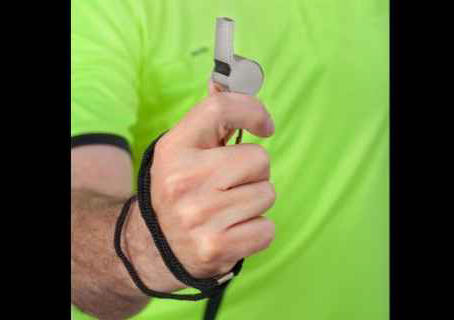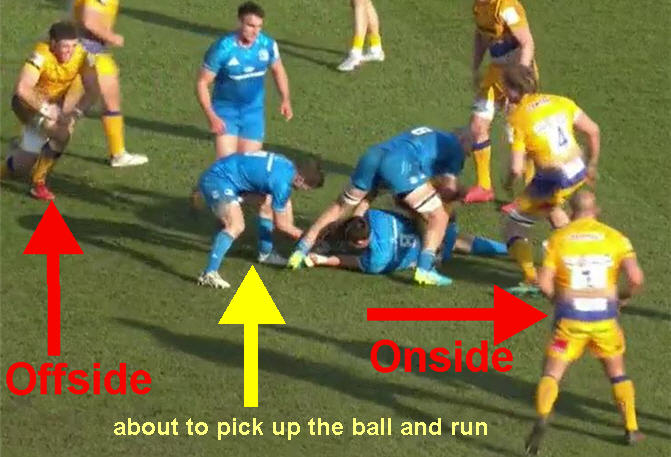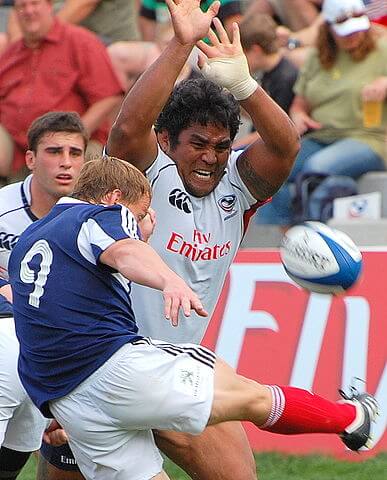A knock on in rugby occurs when a player drops the ball forward or the ball hits off their hand or arm and moves forward.
If the ball hits the ground or another player catches it, the referee awards a knock on infringement.
If the ball moves backward from a fumble, a knock on does not occur.
When the ball hits a player’s chest, knee, or head and ricochets forward, a knock on does not occur either. Only the hand or arm must be involved.
When Do Knock Ons Usually Happen?
It can be a hard watch when your team keeps dropping the ball. But why does it happen?

Knock ons most frequently occur when a player drops a pass or fails to catch and hold a ball from a kick. The most typical reasons are:
- Wet conditions
- Taking eyes off the ball
- Fumbling a catch from a kick
Wet conditions
Rugby is a winter sport in many countries. This means that players are trying to catch a wet slippery ball. You may hear a commentator describe the ball as “a bar of soap”.
Players in wet climates will do plenty of practice sessions to master the skill of passing and catch a wet ball. Sometimes the coach will bring out a hose onto the pitch to keep wetting the ball!
Some players like to use grip spray to reduce fumbles.
Taking eyes off the ball
Unless the pass from a teammate is too far forward or flung too hard, a decent rugby player should be able to catch it.
But even seasoned international players can fumble a pass near the opposition try line.
You may hear the commentator say that “he took his eyes off the ball.” This is a common mistake in rugby.
As the play unfolds and the player is about to take a pass, he has a quick look at the opposition to decide on what he’s going to do after he receives the ball.
In doing so, he doesn’t catch the ball cleanly and it fumbles forward.
Fumbling a catch from a kick
A typical move in rugby is for the outhalf or another kicker to launch a high kick downfield.
The best outcome for the kicker is when an opponent tries to fumble the dropping ball forward.
Now the kicker’s team has a scrum deep in opposition territory.
Backs must practice catching kicks under pressure and you’d expect professional players not to fumble too many. But the introduction of the elements makes life more difficult.
A swirling wind moving a spiraling dropping ball can result in spilled catches.
What Is A Deliberate Knock On?

Most knock ons are due to poor execution of skills i.e. a mistake by a player. These are accidental knock ons and the result is a scrum to the opposition.
However, referees may decide that a player deliberately knocked the ball forward.
Why would a player do that?
Typically, the team in possession has got themselves into a position where they have an overlap in attack.
As they pass the ball across the backline, the opposition has fewer players in defensive positions. This should put the widest attacker through with an unopposed run to the try line.
Instead of tackling the second-last attacker, defenders may shoot up to intercept the pass. If they simply stick one hand out and hope the ball sticks to it, then the likelihood is that they will bat the ball forward.
The referee will adjudicate this as a deliberate knock on and award a penalty to the opposition.
If the knock on prevented a clear try-scoring opportunity, the referee may award the opposition a penalty try. The culprit is also likely to get a yellow card for cynical fouling.
What Happens After A Knock On?
Several scenarios can occur after a knock on.
Advantage

Referees will try to play advantage when a team has knocked on. If the opposition gets possession of the ball, the referee will allow play to continue for a few phases.
If the opposition doesn’t get an advantage, then the referee will call play back for a scrum (or a penalty if the knock on was deliberate).
Advantages for knock ons are usually shorter than other penalty infringements. If the opposition passes the ball through the hands and kicks it down field, the referee is likely to call “advantage over” and play continues as normal.
You can learn more in our article on the advantage rule in rugby.
Two knock ons
When one team knocks on, the other team will scramble for the ball. Often enough, another player will try to pick up the bobbling ball and knock it on too.
As now there are two infringements, the referee can’t let play continue.
The referee will call “two knock ons” and stop play for a scrum. The team who committed the first knock on hand possession over to their opponents to put in the ball.
Offside
Players are not allowed touch the ball when they are in an offside position.
Take a look at this ruck. The blue scrumhalf is about to pick up the ball. He is behind the big number six who is bending over the fuck.

If the scrumhalf mistakenly knocks the ball forward, the number six might try to jump onto it to secure possession.
But as he is in front of the player, he would be touching the ball from an offside position. Thi is a penalty infringement.
Is Off The Head A Knock On In Rugby?
Knock ons are only given when the ball comes off the hand or arm of the player.
Occasionally you’ll see an unsympathetic pass fired too high at a teammate who gets a sore noggin when the ball ricochets forward of his head.
This is not a knock on and the player’s teammates can rush forward to try and regather possession.
You may see the referee pat his head and shout “off the head”. This is to indicate to players that normal play is continuing.
You can read more in our article on whether rugby players are allowed head the ball like in soccer.
What Happens If The Ball Is Knocked Forward From A Knee?
There is no law against kneeing the ball forward. The only disadvantage is that players have very little control over the direction of the ball. So, it’s usually only done accidentally.
Either way, it’s not a knock on.
You may see the referee point at his knee and shout “off the knee”. This indicates to the players that there is no infringement.
Why Isn’t A Charge Down A Knock On?

You’ll often see tall forwards launching themselves superman-style at a scrumhalf who is trying to kick the ball away from a ruck.
Occasionally the ball hits their palms and ricochets in the opposite direction. This is called a charge down and is not an infringement?
But why isn’t it also a knock on? The reason is that charge downs are explicitly given as an exception in the law books.
You can read more in our article on blocking kicks in rugby.
Knocking On In The Act Of Scoring

The picture above shows Scotland fullback and captain Stuart Hogg touching the ball down over Ireland’s try line. It should have been a try.
Unfortunately for Scotland, the player loses control before the ball hits the ground. This is a knock on and the try is not awarded.
It’s a bit of a howler for any player, let alone one as good as Hogg! But there’s worse.
What about a sevens winger who runs over the line unopposed and throws himself into the air…and drops the ball?
And the flyhalf who runs over the try line blowing kisses to the fans…and has the ball batted out of his hand?
Have a good chuckle: